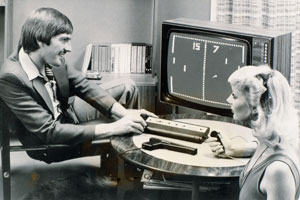
29 November 1972
In 1958, scientists in New York made a primitive computer game called ‘Tennis for Two’. But it wasn’t until 1971 that the first attempt at a mass-market, coin-operated video game emerged.
‘Computer Space’ proved too complicated and received few orders. But its creators went on to found Atari, which in 1972 came up with a hit.
Inspired by a game bundled with the early home computer system Magnavox Odyssey, Pong allowed two people to play simulated paddle tennis against each other.
The simple concept, combined with deliberate design quirks to ensured games were limited in length, proved such a hit that Atari scrapped plans to develop it with other firms and launched the product on its own.
Atari initially struggled to keep up with demand, and before long games machines were appearing everywhere.
Rivals entered the market with clones; others worked on fresh ideas. The arcade industry boomed, helped by games such as Space Invaders (1978) and Pac-Man (1980).
Eventually, the market become saturated: machine sales peaked at $8bn in 1981 ($25.2bn in today’s money), although they remained high throughout the 1980s.
But Pong’s greatest legacy lay in the boost it gave the development of home computer games, starting with the home version of Pong in 1975, which sold 150,000 units in the first few months of release.
On its first day of release this month, over a million PlayStation 4 units were sold globally.